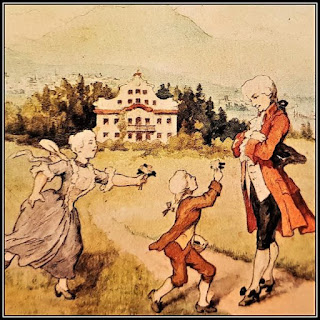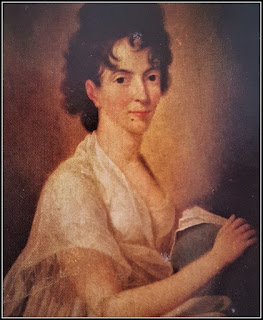The optimism and serenity of Mozart's music is in stark contrast to a life of debt-chewing and an incurable anxiety.
Mozart was a child prodigy. Born on January 27, 1756, he played without difficulty any melody he heard on the piano at the age of three, violin at four and composed music at the time he gave his first public concerto, that is, when he was five and a half years old.
 |
A painting of the time, presents the Mozart
playing with his father and his sister Maria-Anna
in the garden of the house of his children’s
years in Salzburg. |
His life was full of music. Even in his games, young Wolfgang used to move from room to room, to the lively melody of a march. In the age of 12 years he had written three operas, six symphonies and hundreds of other works.
European tours
Mozart's father, Leopold, was a composer and a virtuoso violinist in the service of the Archbishop of Salzburg. He understood that Wolfgang's extraordinary talent could bring significant economic benefits and organised tours of Europe to showcase his son's unique musical gift and secure him an independent future.
From the age of six and for eleven years Mozart toured Europe. Maria Anna, called “Marianne” - his sister, four years older than him, was a talented chebalist. The two children demonstrated their talent in all the major cities and in all the major houses of Europe.
A watercolor of the time, presents theMozart playing with his father andAnne-Marie's sister in the garden of the houseof his children's years in Salzburg.
Mozart played for most of the crowned men of the time, such as King George III. In London, the crowds paid too much to see him play and entertained with his tricks, such as four-handed executions on the harpsichord with Maria-Anna, with the keys covered in fabric.
This unnatural life of incessant movements had its impact on Mozart's health and personality. Smaller and slimmer than children his age, he was always sick, lived with the threat of illness and was infected with typhus that persecuted him all his life.
His cheerful mood made him popular and he immediately felt comfortable with the people he first met. But because he was on a constant commute he had very few opportunities to establish closer relationships and never had any real friends.
 |
| Young Mozart was the favourite of the European aristocracy. They rewarded him with a multitude of gifts for his performances, often with his own compositions. |
Mozart returned home in 1773, where he remained for four years, before embarking on a tour in Germany. At Leopold's request, he was accompanied by his mother and managed to distract himself from Aloisia Weber. She was a 16-year-old soprano whom Mozart met at the age of twenty-one in Mannheim. He fell in love with her and if his mother hadn't intervened, he would have given up his tour and future and followed her.
He traveled to Paris where he didn't have much success. Mozart was no longer the admirable virtuoso child of the piano, and after all, the public's attention was focused on the long-running feud between the composers Gluck and Puccini. Thus, when his mother died in July 1777, he accepted a permanent job as an organist in the Archdiocese of Salzburg and returned home.
Wedding in Vienna
He didn't stay long. Mozart found the restrictions intolerable and resigned. The furious Archbishop, furious at the loss of an official with such prestige, had his servants literally throw him out of his palace. Mozart went to Vienna and settled at the home of Aloysia Weber's mother.
Aloysia was now married, so Mozart's interest turned to her sister, Constanze.
Despite Leopold's objections, they married in 1782 and were relatively happy. Their relationship wasn't passionate, but both of them were playful characters and made good company. Suspicions about Mozart's love affairs were offset by rumors that the last of their six children was not his, but from his correspondence he seems to have been devoted and that he no doubt wanted Constanze when he was away from her.
 |
Constanze Weber for whom Mozart said,
"Her beauty is in two small black eyes
and in her cute form. She has no spirit,
but she has enough common mind to
fulfill her duties as wife and mother." |
Mozart was very well paid for his time. He received fees for compositions, interpretations and lessons. Of his three richest students, he earned 700 guldens a year. But neither he nor Constanze had the slightest idea how to manage their finances, so they never had any money.
Impatience was another of Mozart's problems. He could never stay long in one place and constantly felt the need to change environment. In the course of a year he changed residence nine times.
He needed a place in the Court because it would give him the protection and stability that would ensure his life.
The opportunity was presented in 1787. Emperor Joseph II admired Mozart's work, but his court favored his rival, the Italian composer Antonio Salieri.
Mozart was deeply disappointed when the emperor appointed Salieri as director of the royal orchestra, while he had to settle for the position of courtier musician, which meant he was obliged to compose dances and light music to order.
 |
Mozart at the age of about 30.
The sufferings of the incessant
disease, left their stamp in his
face, to show even 20 years
older. |
Cruel poverty
Mozart became an independent musician again, accepting everything presented to him.
In the last four years of his life, amid extraordinary poverty and debt, Mozart has created some of his most beautiful works, such as Don Giovanni and The Magic Flute.
In the fall of 1791, Mozart was very ill and stayed in bed until November 20. On December 1st, he was appointed music director at St. Stephen's Cathedral of Vienna. This fact is capable of solving his financial problems forever. But it was too late.
He died four days later.
They have described Mozart as the man who was "an adult in his childhood and a child in his adult life." He was unable to develop a personality capable of achieving a happy or complete life, but inexplicable how, all this wonderful music spontaneously sprung up almost from within. She was one of the most creative geniuses ever to appear.




Comments
Post a Comment